Basic definition of 1 on 1 in basketball
1 on 1, also referred to as 1 vs. 1 or 1v1, occurs when one particular player competes against another player on a basketball court in an attempt to score points as it relates to offense or prevent the opposition from scoring in terms of defense, ultimately to win a game.
Basic diagram examples of 1 on 1 situations
The following diagrams below attempt to illustrate basic examples of 1 on 1 situations that could occur on a basketball court between an offensive player and a defensive counterpart.
It should also be noted that for all of the diagrams, each offensive player is represented by a number that generally indicates one of the standard basketball positions and each defensive player has a correlated number to a similar position that is shown alongside the letter X.
Essentially, 1 is the offensive point guard while X1 is the defensive point guard.
2 is the offensive shooting guard while X2 is the defensive shooting guard.
3 is the offensive small forward while X3 is the defensive small forward.
4 is the offensive power forward while X4 is the defensive power forward.
Lastly, 5 is the offensive center while X5 is the defensive center.
1 on 1 situation with offensive player in possession of ball at the top
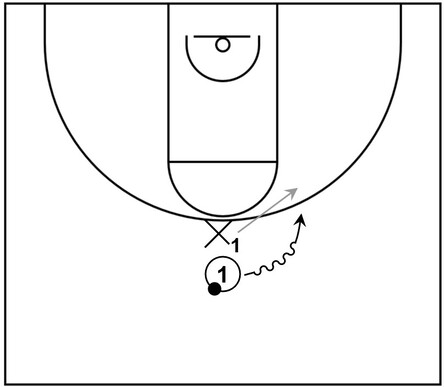
This is a very basic diagram example of a 1 on 1 situation when an offensive player, signified as 1, has possession of the ball, represented by the black dot, at the top behind the three-point line.
Conversely, a defensive player, indicated as X1, guards against 1 and attempts to prevent 1 from scoring points.
Initially, X1 should utilize a proper defensive stance, which consists of having the feet slightly wider than shoulder width apart, the knees bent, and the back straight while maintaining balance.
Furthermore, X1 should remain on the balls of the feet and not stand flat-footed while also placing the hands and arms extended away from the sides of the body.
To begin the action, 1 dribbles toward the right side of the court, which is represented by the arrow with a wavy line.
From that point, X1 who is initially in the standard defensive stance, reacts to that dribble action by laterally sliding with the left foot leading first followed by the right foot afterwards, ultimately to stay in front of 1.
This is showcased with the gray arrow that follows the path near the dribble action of 1.
If X1 is able to achieve the objective of staying in front of 1, then generally speaking, X1 could potentially put a hand up near the face of 1 to contest a close-range shot such as layup or a perimeter-oriented shot from mid-range or three-point range.
Additionally, it should be mentioned that depending on the type of game that is being played, if 1 scores one or more points, then 1 could transition into a defender while X1, who was scored on, could transition into an offensive player.
So in that instance, the current 1 would become the new X1 while the current X1 would become the new 1.
An example of this is briefly described in a sub-section below called ‘Winner’s take or loser’s take’, which is also within a section called ‘What are the rules for a 1 on 1 pickup basketball game’.
1 on 1 situation with offensive player in possession of ball on right side wing
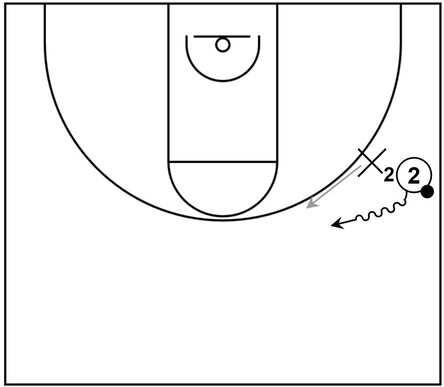
This is another basic diagram example of what a 1 on 1 situation could look like on a basketball court.
In this instance, an offensive player, indicated as 2, has possession of the basketball near the right side wing area while being guarded by a defensive player who is indicated as X2.
In addition, notice that X2 is using a sufficient amount of defensive pressure by guarding 2 very closely.
The implication here is that 2 possesses an above average three-point jump shot. Therefore, X2 does not want to give any unnecessary open space so that 2 can easily take a fully uncontested or even a semi-contested three-point jump shot.
Also notice that X2 is slightly below 2 and positioned more towards the baseline area. In this 1 on 1 scenario, the assumption is that 2 shoots the basketball with the right hand and prefers to dribble with that same hand as well.
So, 2 would essentially be forced to dribble with the left hand towards the middle of the floor or towards the free throw line area because X2 is attempting to cut off the right side of the court.
Moreover, for demonstration purposes, 2 does indeed dribble towards the middle of the court, presumably with the weaker left hand, and when that occurs, it should be much easier, at least in theory, for X2 to contain the ball and stay in front, shown with the gray arrow.
1 on 1 situation with offensive player in possession of ball on left side wing
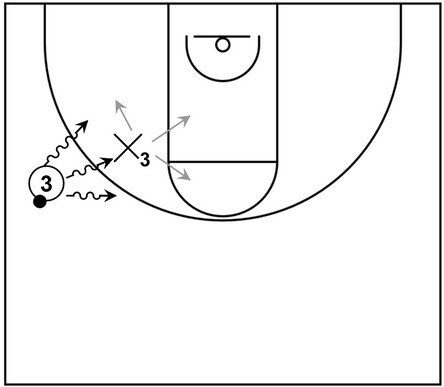
This is a diagram example of a 1 on 1 situation when an offensive player, denoted as 3, has possession of the ball on the left side wing.
Also, notice that X3 is not implementing anywhere close to the same amount of defensive pressure as X2 in the previous diagram.
The general implication here is that 3 is a slasher with athleticism who can utilize speed and quickness to blow by an opposing defender.
Therefore, in an attempt to counter the potential ability of 3 to attack the rim and score via a high-percentage shot near the basket, X3 plays a sagging type of defense and essentially dares 3 to take the open jump shot.
Moreover, notice that if 3 does decide to dribble towards the basket from the left side, right side, or straight ahead, it would be easier for X3 to react and cut off those respective dribbling routes, represented by the various gray arrows.
1 on 1 situation with offensive player in possession of ball in the high post
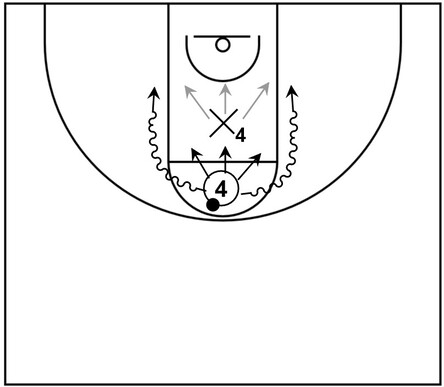
This is an example of a 1 on 1 situation when an offensive player, indicated as 4, has possession of the ball in the high post area.
Moreover, X4 plays standard defense and is not applying too much pressure or sagging back away from 4, mainly to influence a potential jump shot.
Therefore, 4 could utilize utilize different basketball moves to generate a certain amount of open space from X4.
To demonstrate that concept, let’s say that 4 decides to use a jab step to create space from X4, which is represented by solid black arrows on the diagram.
4 could effectively jab step in the directions relating to the rightmost arrow, the middle arrow, or the leftmost arrow.
Subsequently, the jab step could cause X4 to counter any of those directions, which are shown with gray arrows.
Afterwards, 4 could take an open jump shot or drive on the opposite side of the jab step.
So, if 4 were to jab step in the direction of the rightmost arrow and X4 also attempts to cut off that path with the gray rightmost arrow, then 4 could dribble and attack the rim on the left side.
1 on 1 situation with offensive player in possession of ball near right side low post
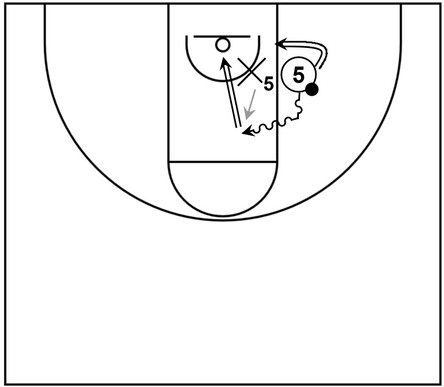
This is an example of a 1 on 1 situation when an offensive player, indicated as 5, has possession of the ball near the low post area on the right side of the court.
Furthermore, X5 plays straight defense and is not attempting to overplay on the low side near the baseline or the high side near the mid-post.
From there, 5 could attempt a field goal on either side by way of low post moves such as a hook shot, up and under, or fadeaway shot.
For example, 5 could turn towards the baseline and attempt a low post shot, which is represented by the wide arrow that is above 5.
Conversely, 5 could dribble towards the lane area and that dribble action could possibly influence X5 to slide laterally to stay in front, which is shown with the gray arrow.
Following that, 5 could take a short jumper or low post shot, which is indicated by the wide arrow inside of the lane area.
1 on 1 special situation: Isolation
In certain formal or informal games when there is more than one offensive player and more than one defensive player on the court, a special situation, typically known as a 1 on 1 isolation could occur.
During a 1 on 1 isolation, one offensive player in possession of the basketball as well as one defensive player compete against each other while any additional players remain separated or isolated from the ball.
The following diagram below illustrates this concept.
1 on 1 isolation with offensive player in possession of ball near left side wing area
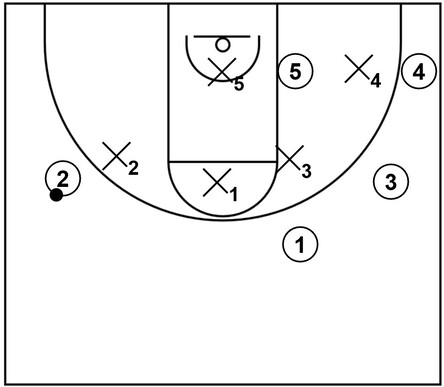
This is a basic example of a 1 on 1 isolation when an offensive player has possession of the ball near the left side wing area.
On the diagram, there are five offensive players as well as five defensive players on the court so it is effectively 5 on 5 play.
However, notice that the offensive players signified as 1, 3, 4, and 5, are on the right side of the court while the other offensive player in possession of the ball, indicated as 2, is given an isolation opportunity against the defender denoted as X2.
From there, 2 could utilize the whole left side of the court to potentially create an individual scoring possibility or additional scoring opportunities for other teammates.
Also notice that specific off-ball defenders, most notably X1 and X3, have moved slightly away from their respective assignments of 1 and 3 to provide help defense for X2 if necessary.
Furthermore, note that X5 is positioned directly in front of the basket to protect the rim while still being just about or slightly more than an arm’s length away from 5.
General rules for a 1 on 1 pickup basketball game
This is a basic explanation of the general rules for a 1 on 1 pickup basketball game, which is typically played at an indoor gym or outdoor court.
However, it should be mentioned as well that these rules could vary based on player preferences and are therefore not set in stone.
These rules could also generally apply to other similar variations such as a 2 on 2, 3 on 3, or 4 on 4 pickup basketball game.
Half court
Players typically only use one half of the court and both team use the same basket for scoring purposes.
This is also different from a full court basketball game where both teams would have a backcourt as well as a frontcourt.
Pregame first possession
Prior to the start of the 1 on 1 game, the two players could do something as simple as flip a coin to determine who would receive the ball first.
However, in most cases, the two players would usually take jump shots, particularly from three-point range until one of them makes a jump shot while the other one misses the next shot. Once that occurs, the player that made the shot would receive first possession of the basketball.
To give an example, let’s say that player 1 makes their jump shot but player 2 misses their jump shot. As a result of that, player 1 would receive the ball first.
Conversely, let’s say that player 1 misses their shot but player 2 makes their shot. As a result, player 2 would receive the ball first.
Moreover, if player 1 and player 2 miss their shots, both players could continue taking turns shooting until one of them makes a shot while the other misses a shot.
Alternatively, the two players could participate in another variation of the pregame shooting performance.
In this secondary variation, one particular player would take the three-point jump shot. Afterwards, if the ball goes into the basket, then the player who shot it would receive it first.
Nevertheless, if that same particular player misses the shot, then the opposing player would receive the ball first.
Basically, the secondary variation is simple and the first possession could be determined at a faster pace.
However, it could be more riskier for either player, depending on the three-point shooting ability of the player who would be taking the shot.
Points
In most cases of 1 on 1 pickup games, when an offensive player makes a field goal inside of the three-point line, this is usually worth one point as opposed to the standard two points, which is typically recorded within formal basketball games.
Moreover, when an offensive player makes a field goal outside of the three-point line, this is typically worth two points as opposed to the standard three-points, which is typically recorded within formal basketball games as well.
Also, 1 on 1 pickup generally does not implement a game clock that would normally determine the winner based on who has the most points at the end of the timer.
Instead, the player that scores a certain amount of points first would be the winner of the game.
It should also be mentioned that 1 on 1 pickup also does not usually include a shot clock so players are not required to shoot the ball within a specified number of seconds.
It should be noted as well that sometimes within a 1 on 1 pickup basketball game as well as other similar variations, a skunk rule could be established by the players, prior to the game or during the game.
This generally means that if one particular player has a significant lead in points that is much higher than the opposing player, then that same opposing player would automatically lose the game.
For example, if player 1 has 8 points and player 2 has 0 points (in other words, player 2 did not score any points), then this might qualify as an automatic loss for player 2, according to the skunk rule.
Essentially, the chance of player 2 diminishing player 1’s lead or the probability of player 2 taking the lead themselves is slim to none.
Therefore, it is usually better for player 2 to simply concede the loss and potentially start a new 1 on 1 game.
In addition to that, players might decide to institute a win by two rule. This basically means that one player would need to have a two-point lead over the opposing player upon reaching or exceeding the final score, which would also be determined prior to the game.
For example, let’s say that the two players agree that either of them has to score at least 15 points to win the game. Let’s also say that both players have 14 points at a certain point during the game.
From there, with the win by two rule in place, if player 1 scores one point to increase their total to 15, then that same player would not win the game.
Following that, if player 2 does not score and remains at 14 but player 1 is able to score one or two points to increase the lead to 16 points or 17 points respectively, then player 1 would win that particular game.
Rebounds
The rule for offensive rebounds is usually similar to the rules of formal full court play.
Basically, when a player gets an offensive rebound, that same player can try to score immediately or even dribble the ball if desired.
However, the rule for defensive rebounding within a 1 on 1 pickup basketball game is usually different.
Essentially, in a full court game setting, when a player for a particular team collects a defensive rebound, that would initiate transition offense action for that player’s team, which would also initiate transition defense of the opposing team.
Nonetheless, within a typical 1 on 1 pickup basketball game, when a player gains a defensive rebound, the ball usually has to clear a certain perimeter area of the court, which is commonly the three-point line.
This rule for defensive rebounding is typically instituted as a way to give the opposing player enough time to protect the basket since both players do not have their own backcourt or frontcourt as within a full court 5 on 5 game.
Put another way, without this rule, a player who is initially on defense could potentially grab the rebound and quickly score before the opposing team is able to react and defend the basket.
In most cases, this would probably be an unfair advantage, especially if that same player possesses a height or athletic advantage over the competition.
Additionally, it should be mentioned if a player does not clear after receiving the defensive rebound, then the other player could call for a non-clear rule break and receive possession of the ball.
Winner’s take or loser’s take
The winner’s take rule, which is sometimes referred to as “make it, take it” basically means that when a player scores points on offense, that same player would receive the ball immediately afterwards.
Essentially, with the winner’s take rule, if the offensive player is able to score continuously either by not missing shots and/or by grabbing offensive rebounds, which could lead to second chance points, then the opposing defensive player may not ever receive the ball in a game.
On the other hand, the loser’s take rule is opposite of winner’s take. That is, when the offensive player scores, the opposing defensive player receives the ball. Afterwards, the player that just scored becomes the current defender while the player that was scored on becomes the current offensive player.
In a basic sense, the loser’s take rule allows both players an opportunity to gain offensive possession of the basketball.
In terms of implementing winner’s take or losers’ take, this is typically determined by the players on the court prior to the game.
After a made basket or valid call
After a made basket or valid call, the player who should gain possession of the ball would receive it at the top, usually above the three-point line or closer to the midcourt line, which would also serve as the half court’s endline.
Check
Additionally, after a made basket or valid call, the defensive player can call “Check!” to briefly receive the ball from the player in possession of it prior to offensive execution.
Following that, the defender can examine the ball and give it back to the offensive player, prior to defensive execution.
Out of Bounds
Since players typically play on one half of the basketball court, the primary boundary lines will include the two sidelines as well as the adjacent baseline and the midcourt line.
Therefore, if a player has possession of the ball and then the player touches one of those boundary lines or passes over one of those boundary lines with a part of their body such as their foot, then this would be considered out of bounds.
Also, if a player was the last to touch the ball with or without possession of it and then the ball makes contact with or passes over one of those aforementioned boundary lines, then that would be considered out of bounds as well.
Afterwards, the opposing player would gain possession of the ball, usually at the top area near the midcourt line.
Calls in relation to fouls or violations
In most cases within informal or recreational play such as a 1 on 1 pickup basketball game, the players will make their own calls, especially in relation to fouls or other violations.
Moreover, when a potential dispute arises in reference to valid or invalid calls, the players will typically attempt to settle it by shooting the ball.
Basically, the player who made the initial call for a foul or violation would shoot a three-pointer. If the shot goes into the basket, then the call would stand. Otherwise, the call would be reversed or negated.
Examples of additional basketball games that could be played 1 on 1
21
21 is a basketball game that features at least two players and in the case of 1 on 1 action, one particular player would begin on offense while the other player starts on defense.
21 typically follows standard basketball rules. So, one player could possibly call a violation such as traveling, carrying, or a foul on the other player.
However, similar to various types of pickup basketball games, it is possible for rules to be altered to one degree or another depending on the players’ preferences.
Prior to the 21 game, to determine who would receive the ball first, the two players could shoot the ball a certain number of times until one of them misses.
Alternatively, as another option, one of the players could shoot the ball and receive it if the ball goes into the basket as mentioned in a previous section.
Also, during the game of 21, each score is typically only worth one point but it is possible for players to agree that made three-pointers to be worth two points.
Furthermore, if one particular player scores one point or two points, then that same player would receive at least one additional shot which would also be worth at least one point.
Players could determine as well if that additional shot would be a free throw or a three-pointer.
Following that, if that same player makes the first additional shot, then that same player would usually be able to take up to two additional made shots for a total of three free shots.
Players could also agree on taking an unlimited amount of additional shots until a shot is missed.
After missing a shot, the opposing player could grab the defensive rebound or the shooter could grab their own miss via an offensive rebound.
It should be noted as well that when an opposing player grabs a defensive rebound, they would usually be required to clear the ball behind the three-point line.
This gives the player that missed an opportunity to transition into a defender and protect the basket or play on-ball defense.
This process continues until either player scores at least 21 points in the game.
Around the World
Around the world is a type of basketball game that typically consists of two or more players who attempt multiple shots from different spots around the basket until one of the players makes the final shot at the designated last spot to win the game.
Around the world could help players shoot the ball more consistently over time from different areas of the court.
Furthermore, around the world is a simple yet effective method of implementing general fitness and basic physical conditioning, especially for beginners.
Prior to playing the game, the players will select the designated shooting spots on the court. Also, these spots are generally equidistant from each other and commonly spaced around the perimeter areas of the court.
Additionally, all of the shooting spots would normally be within the three-point line or outside of the three-point line.
The typical spots within the three-point line would be the short corners near the baseline, the extended high post elbow areas that are just inside of the three-point arc near the wings of the court, as well as the high post area itself near the free throw line.
Similarly, the usual spots outside of the three-point line would be the corner areas adjacent to the sideline and baseline, the wing areas, and the top area.
It should also be noted that in some variations of around the world, players might decide to select certain spots near the low post blocks in addition to the previously mentioned spots.
Moreover, in uncommon variations of around the world, players could even designate shooting spots that are in the lane, which would require participants to shoot layups or floaters as well as various types of jump shots.
Athletic traits to generally consider for 1 on 1 action
Speed
Speed in basketball generally consists of a player’s ability to move from one area of the court to another area, especially in a vertical direction, which would be up and down the court, in the shortest amount of time as possible.
In essence, one particular basketball player with a moderate to high degree of speed would almost certainly be able to move up or down the court from point A to point B at a much faster rate than another player with a lesser degree of speed.
Speed is potentially effective for an offensive player during 1 on 1 action because it could help that player blow by the defending opposition, particularly with an explosive first step, which could then lead to a scoring opportunity near the basket or even an open perimeter jump shot.
Speed could also help a defensive player stay in front of the offensive player to contain the ball.
However, in the event that a defender does get beat by an offensive player’s dribble action, that same defender could still use their speed and general athleticism to prevent a potential scoring opportunity, especially a layup, by executing a chase down block.
Quickness
Quickness in basketball generally consists of a player’s ability to swiftly change direction, primarily going east or west, particularly with good footwork, when necessary.
Furthermore, a basketball player’s quickness could also be determined by their reaction time to something occurring on the court.
In terms of 1 on 1 action, offensive players can benefit from quickness when executing perimeter or low post moves and/or countering against certain defensive actions.
For example, let’s say that an offensive player in possession of the ball near the right side wing area dribbles it toward the baseline with their right hand.
However, let’s also say that the on-ball defender performs a proper defensive sliding technique to effectively cut off that drive.
As a result, the offensive player could quickly react to that defensive action by executing a right to left behind the back dribble and then move in the opposite direction towards the lane.
Conversely, a quicker defensive player, especially near perimeter areas of the court, would generally have a much easier time sliding laterally to stay in front of the offensive player that they are guarding.
Moreover, if a defensive player possesses a greater amount of quickness than the opposing offensive player, then it would be much more challenging for that offensive player to dribble towards the basket.
As a result of less dribble penetration, there would generally be a reduction in the number of close-range shots, most notably layups, which are the highest percentage shots in the game of basketball.
Additionally, a quicker defender could more easily react to certain actions of the offensive player that they are covering, which could also lead to limited scoring opportunities for that offensive player.
As an example, let’s say that an offensive player executes a step back to create separation and raise up for a jump shot.
When that happens, a defender that possesses an adequate amount of quickness would still have a higher chance of contesting the jump shot and potentially blocking it than a defender with less than ample quickness.
Vertical Jump
Vertical jump or vertical leap in basketball generally consists of a player’s ability to jump in the air as well as the distance between the player’s feet and the ground.
Essentially, the greater the distance between the ground and the player’s feet after jumping in the air, the higher that player’s vertical jumping ability.
For 1 on 1 action, if an offensive player possesses a vertical jump that is greater than the opposing defender, then it would typically be much more challenging for the opposing defender to contest the shot or totally block it.
This could also lead to more high percentage scoring opportunities such as layups near the basket or perimeter jump shots that may not be available without an abundant vertical jumping ability.
On the other hand, if a defensive player possesses a vertical jump that is greater than the opposing offensive player, then it would usually be much easier to contest or block shots, which basically means it would be much more difficult for the offensive player to score points.